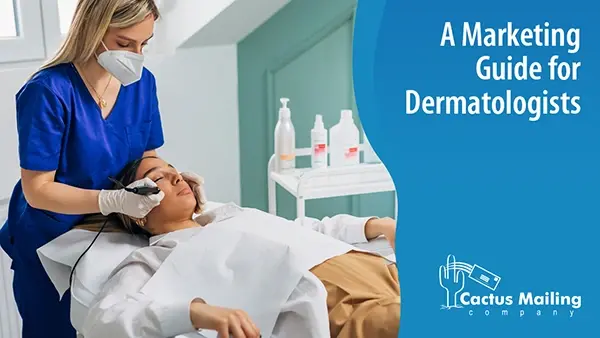We Are Here to Help!
What to Expect from Us:
No Pressure, Just Service!
Get no obligation pricing details and strategies that will work for your business.
Marketing for dermatological services can be challenging. While dermatology is not necessarily a highly specialized service, it tends to be a medical field that is less recognized by the general public in comparison to something like dentistry. Additionally, depending on the services you offer at your practice, identifying potential patients who do need specialized dermatological care can be difficult. When you find those patients, you must educate them about the benefits of dermatological care and show them that your services can improve their quality of life. If you're a dermatologist who finds themselves overwhelmed with the marketing landscape, continue reading for advice on how to improve your marketing strategy.
The Importance of Marketing Strategy
A marketing strategy refers to your comprehensive plan regarding how you promote and advertise your practice's services. This encompasses everything from your objectives to your target audience, the media channels you utilize, and even how you allocate budget. Your approach to marketing requires a pre-planned strategy in order to maximize the return on your investments. For short-term efforts, your marketing strategy will guide the creation of campaigns by providing the goals and the target audience, among other details. Long term, however, your marketing strategy should adapt to reflect your unique marketing funnel–the path that your practice utilizes to guide patients from brand awareness to conversion.

Optimize Your Website for Patients
Online presence is a great place to start planting the seeds of your marketing strategy. With the prevalence of digital media, it’s likely that most of your patients will interact with your website at some point, so it's important to have it optimized as early as possible. Think of your website as a highly-customizable representation of your brand that serves as a hub of information about your practice. It will help bring in patients who have concerns about their skin and are looking for solutions that you may be able to provide.
SEO and Content Creation
If someone starts to experience symptoms of skin irritation or they have a concern about their complexion, they will often go to Google to find an explanation and a solution. By offering information related to these potential queries, you can catch additional searchers, guiding them to your website. Blogs are an effective strategy because you can write or commission articles that answer dermatologically related queries and showcase your expertise. Additionally, having an active blog will signal to Google that your website is frequently updated, which enhances your ability to achieve higher rankings in search.
Here are some topic ideas you may want to consider for your blog:
- Skincare routines and tips for different skin types
- Explanation of SPF and how to choose the right sunscreen
- Common skincare mistakes or misconceptions
- Acne causes and treatment options
- Managing chronic conditions like eczema and psoriasis
- How to identify early signs of skin cancer
- Causes and available treatments for other skin conditions
- Cosmetic dermatology and the effects of treatments like botox, chemical peels, and microneedling
- Lifestyle topics such as nutrition and sleep routines for healthy skin
- Practice-specific topics like highlighting members of your team or client testimonials

User Experience
You should also pay attention to the functional performance of your website. If you have long load times for pages or several links that return a 404 error, this will negatively impact your ranking placement for search queries. To avoid this, you should run a technical audit of your website to see where you can make improvements. Try to reduce loading times where possible and redirect links with missing pages to elsewhere in the site. Be sure to regularly check the technical status of your website and perform maintenance to ensure that your rankings don’t drop.
While not directly related to search ranking, ease of navigation also plays a part in keeping visitors engaged with your website's content. Visitors should be able to easily find the content they want via navigational menus–and the sitemap should be laid out in a way that makes logical sense. Failure to make your site straightforward will result in problems like higher bounce rates (users leaving the site immediately) causing you to lose potential clients. Check your sitemap and see if it follows a logical hierarchy through which the average person could be reasonably expected to find the content that they're interested in.
Leverage Social Media to Engage Patients
Social media can become another component of your overall marketing strategy, as it allows you to interact with your followers and post content related to your practice and its services. Across various platforms, you can create and post content that showcases your expertise in the field of dermatology. Highlight your services and show before-and-after photos to illustrate the effectiveness of your treatments. Some platforms even allow you to host live Q&A sessions to discuss your services with followers directly. The photo-centric nature of Instagram makes it a great platform for dermatologists.

Collect Patient Testimonials
Asking your patients for testimonials and reposting them on your website and social media accounts is a great way to further showcase the efficacy of your practice's treatments. It will give future patients confidence in your abilities and potentially lead to more conversions. Google reviews, which can be seen via your Google My Business Profile, are also valuable to your online presence. A large volume of mostly positive reviews will act as a signal to Google that you have a good reputation as a business, making your site more likely to appear on the first page of search results for relevant queries. Consider reaching out to your current client base and asking them to review your business if they have not already.
Explore Direct Mail Solutions
Once you have established your brand's online presence, it's time to consider a campaign that reaches out to your local community. Direct mail can be used to build brand awareness or drive website visits, and they can be sent to predetermined audiences. While it may be harder to pinpoint individuals with specific medical conditions, you can target audiences based on sex, age, and income to market to those who are likely to be most interested in treatment. Direct mail postcards are an effective medium because they require no external packaging, so there is nothing impeding the recipient's ability to see your message once they take it from their mailbox.

Postcard Design
Postcards are a visual medium, so you should prioritize visual appeal. This includes making sure that your images are high-quality, your layout is clean, and your branding is consistent. For ad copy, you may want to highlight some of your services briefly in a bulleted list. Avoid overloading your postcard with detailed descriptions of your services. Instead, provide a website address or QR code to take the recipient to a page where they can read more in-depth information.
A strong Call-to-Action statement should be included on your postcard to instruct the recipient on what to do next. This CTA should align with a predetermined objective of your campaign like increasing website visits or trial signups. Make sure that your postcard includes what is needed to complete the requested action like a QR code leading to the webpage where the recipient can complete the trial signup.
Mailing List Selection
When selecting a mailing list, you'll want to choose zip codes that are within a reasonable driving distance from your practice. There's only so far that most people will be willing to travel, so determine a radius in which to conduct direct mail campaigns. Consider the presence of other practices in your area that offer similar services to yours because you'll be competing with them for business. You may want to begin by targeting zip codes with fewer skin care providers nearby before moving on to areas with more competition.
You can also narrow down your mailing list by demographic considerations. For example, if you have acne treatment services available at your practice, you can target households with parents of children aged 12-18, as teenagers tend to experience more problems with acne. Different demographics of individuals may experience different skin-related conditions and problems, so naturally you should consider creating campaigns that address these groups separately.

Expand Into Search Advertising
Assuming you've taken the necessary steps to optimize your website for functionality and ease of navigation, you may want to consider investing some of your marketing budget into Google Ads. Through Google Ads, you can enhance your ranking in the search results for relevant queries by bidding on specific keywords. This means that you'll be more likely to appear in the top results for internet users who are actively searching for your services. There are different bidding strategies, like pay-per-click in which you will only be charged when users actually click on your search ads. You can also set a monthly budget that Google will automatically adjust for, so you'll never have to worry about going over budget.
Measure the Success of Your Marketing Efforts
For the marketing objective of each campaign you launch, you should decide on a corresponding metric that you can use to measure response. This is known as the key metric of the campaign and it should directly align with what you ask your audience to do in the Call-to-Action statement in your ads. For example, you could measure the amount of direct mail postcard recipients who follow the included QR code. To measure the overall response to your campaign, divide the total number of responses by the total number of ad recipients to see the final response rate of the campaign.

Conclusion
There are many factors to consider when developing your initial marketing strategy, but it's even more important that your strategy evolves and changes over time. With no shortage of factors to keep track of, it can become overwhelming quickly. Cactus Mailing can lighten your workload when it comes to developing your direct mail postcard campaigns. We have over 22 years of experience handling postcard marketing for clients in a wide range of industries, including dermatology. From mailing list selection to design to printing and distribution, we'll help you every step of the way.
Get in contact with a direct mail expert today and receive a free design on your first campaign!

 Nick Ryan: Dec 17, 2024
Nick Ryan: Dec 17, 2024


 Mike Ryan
Mike Ryan

 Jill Brown
Jill Brown